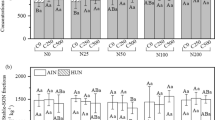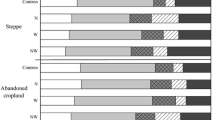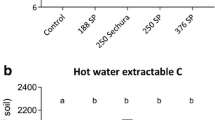Abstract
Increases in the growth rate of plants and microbes in the Mojave Desert in response to predicted increases in precipitation and CO2 due to global climate change may induce nutrient limitations. This study was designed to measure the pool of potentially bioavailable nutrients in soils of the Mojave Desert. Soils were collected from shrub and interspace microsites and then subjected to amendment with buffered solutions of an excess of various enzymes. The products of each enzyme reaction were then measured and the maximum quantity of hydrolyzable substrates was calculated. In interspace and shrub microsite soils, respectively, 14.5 and 9.7% of the organic C in the form cellulose, 60.0–97.8% and 61.2–100.0% of the organic N in the form protein, and 44.0 and 57.5% of the organic P was hydrolyzable. There were significant differences between microsites for hydrolyzable substrate using all enzyme amendments, except protease. We propose that accumulations of hydrolyzable organic C, N, and P in the Mojave Desert could be a result of the persistently dry soil conditions often found in desert ecosystems and the immobilization of enzymes, which may result in low diffusivity of soil substrates and enzymes and, accordingly, little degradation of organic C, N, and P. Alternatively, rapid nutrient cycling and immobilization by soil microorganisms could account for accumulations of organic C, N, and P. Further refinement of the methods used in this study could lead to a valuable tool for the assessment of potential bioavailability of nutrients in a variety of soils.



Similar content being viewed by others
References
Austin AT, Yahdjian L, Stark JM, Belnap J, Porporato A, Norton U, Ravetta DA, Schaeffer SM (2004) Water pulses and biogeochemical cycles in arid and semiarid ecosystems. Oecologia 141:221–235
Belnap J, Phillips SL, Miller ME (2004) Response of desert biological soil crusts to alterations in precipitation frequency. Oecologia 141:306–316
Benbi DK, Richter J (2002) A critical review of some approaches to modeling nitrogen mineralization. Biol Fertil Soils 35:168–183
Billings SA, Schaeffer SM, Evans RD (2002) Trace N gas losses and N mineralization in Mojave desert soils exposed to elevated CO2. Soil Biol Biochem 34:1777–1784
Billings SA, Schaeffer SM, Evans RD (2004) Soil microbial activity and N availability with elevated CO2 in Mojave Desert soils. Global Biogeochem Cycles 18. doi: 10.1029/2003GB002137
Blank RR (2004) Enzyme activity in temperate desert soils: influence of microsite, depth, and grazing. USDA Forest Service Proceedings RMRS-P-31. In: Hild AL, Shaw NL, Meyer SE, Booth TD, Macarthur ED (eds) Seed and Soil Dynamics in Shrubland Ecosystems: Proceedings
Bolton H, Smith JL, Link SO (1993) Soil microbial biomass and activity of disturbed and undisturbed shrub-steppe ecosystem. Soil Biol Biochem 25:545–552
Bowman RA (1989) A sequential extraction procedure with concentrated sulfuric acid and dilute base for soil organic phosphorus. Soil Sci Soc Am J 53:362–366
Brady NC (1990) The nature and properties of soil. Macmillan Publishing Company, NY, USA
Burns RG (1982) Enzyme activity in soil: microsite and possible role in microbial ecology. Soil Biol Biochem 14:423–427
Dosoretz CG, Dass B, Reddy A, Grethlein HE (1990) Protease-mediated degradation of lignin peroxidase in liquid cultures of Phanerochaete chrysosporium. Appl Environ Microbiol 56:395–400
El Gharous M, Westerman RL, Soltanpour PN (1990) Nitrogen mineralization potential of arid and semiarid soils of Morocco. Soil Sci Soc Am J 54:438–443
Elvazi F, Tabatabai MA (1977) Phosphatases in soil. Soil Biol Biochem 9:167–172
Evans RD, Ehleringer JR (1993) A break in the nitrogen cycle in arid lands? Evidence from (15N of soils. Oecologia 94:314–317
Fox RH, Myers RJK, Vallis I (1990) The nitrogen mineralization rate of legume residues in soil as influenced by their polyphenol, lignin, and nitrogen contents. Plant Soil 129:251–259
Fuller WH, Norman AG (1943) Cellulose decomposition by aerobic mesophilic bacteria from soil. III. The effect of lignin. J Bacteriol 46:291–297
Gallardo A, Schlesinger WH (1992) Carbon and nitrogen limitations of soil microbial biomass in desert ecosystems. Biogeochemistry 18:1–17
Grabber JH (2005) How do lignin composition, structure, and cross-linking affect degradability? A review of cell wall model studies. Crop Sci 45:820–831
Green DM, Oleksyszyn M (2002) Enzyme activities and carbon dioxide flux in a Sonoran Desert urban ecosystem. Soil Sci Soc Am J 66:2002–2008
Gregorich EG, Carter MR, Angers DA, Monreal CM, Ellert BH (1994) Towards a minimum data set to assess soil organic matter quality in agricultural soils. Can J Soil Sci 74:367–385
Hayes JE, Richardson AE, Simpson RJ (2000) Components of organic phosphorus in soil extracts that are hydrolyzed by phytase and acid phosphatase. Biol Fertil Soils 32:279–286
He Z, Honeycutt CW (2001) Enzymatic characterization of organic phosphorus in animal manure. J Environ Qual 30:1685–1692
He Z, Griffin TS, Honeycutt CW (2004) Enzymatic hydrolysis of organic phosphorus in swine manure and soil. J Environ Qual 33:367–372
Johnson DW (2006) Progressive N limitation in forests: review and implications for long-term responses to elevated CO2. Ecology 87:64–75
Karbozova-Saljnikov E, Funakawa S, Akhmetov K, Kosaki T (2004) Soil organic matter status of Chernozem soil in North Kazakhstan: effects of summer fallow. Soil Biol Biochem 36:1373–1381
Knicker H, Hatcher PG (1997) Survival of protein in an organic-rich sediment. Possible protection by encapsulation in organic matter. Naturwissenschaften 84:231–234
Ladd JN, Paul EA (1973) Change in enzymatic activity and distribution of acid-soluble, amino acid-nitrogen in soil during nitrogen immobilization and mineralization. Soil Biol Biochem 5:825–840
Lajtha K, Schlesinger WH (1988) The biogeochemistry of phosphorus cycling and phosphorus availability along a desert soil chronosequence. Ecology 69:24–39
Li X, Sarah P (2003) Enzyme activities along a climatic transect in the Judean desert. Catena 53:349–363
Lioubimtseva E, Adams J (2004) Possible implications of increased carbon dioxide levels and climate change for desert ecosystems. Environ Manage 33:S388–S404
Liu X, Lindemann WC, Whitford WG, Steiner RL (2000) Microbial diversity and activity of disturbed soil in the northern Chihuahuan Desert. Biol Fertil Soils 32:243–249
Martens DA, Jaynes DB, Colvin TS, Caspar TC, Karlan DL (2006) Soil organic nitrogen enrichment following soybean in an Iowa corn–soybean rotation. Soil Sci Soc Am J 70:382–392
McClain JET, Martens DA (2005) Nitrous oxide flush from soil amino acid mineralization. Soil Biol Biochem 37:289–299
Melillo JM, Aber JD, Muratore JF (1982) Nitrogen and lignin control of hardwood leaf litter decomposition dynamics. Ecology 63:621–626
Miller GL (1959) Use of dinitrosalicylic acid reagent for determination of reducing sugar. Anal Chem 31:426–428
Molina JAE, Clapp CE, Larson WE (1980) Potentially mineralizable nitrogen in soil: the simple exponential model does not apply to the first 12 weeks of incubation. Soil Sci Soc Am J 44:442–443
Noy-Meir I (1973) Desert ecosystems: environment and producers. Annu Rev Ecol Syst 4:25–51
Otani T, Ae N (1999) Extraction of organic phosphorus in andosols by various methods. Soil Sci Plant Nutr 45:151–161
Pant HK, Edwards AC, Vaughan D (1994a) Extraction, molecular fractionation and enzyme degradation of organically associated phosphorus in soil solutions. Biol Fertil Soils 17:196–200
Pant HK, Vaughan D, Edwards AC (1994b) Molecular size distribution and enzymatic degradation of organic phosphorus in root exudates of spring barley. Biol Fertil Soils 18:285–290
Paul EA, Clark FE (1996) Soil microbiology and biochemistry, 2nd edn. Academic, San Diego, CA, USA
Schaeffer SM, Billings SA, Evans RD (2003) Responses of soil nitrogen dynamics in a Mojave Desert ecosystem to manipulations in soil carbon and nitrogen availability. Oecologia 134:547–553
Schlesinger WH, Reynolds JF, Cunningham GL, Huenneke LF, Jarrell WM, Virginia RA, Whitford WG (1990) Biological feedbacks in global desertification. Science 247:1043–1048
Scott NA (1998) Soil aggregation and organic matter mineralization in forests and grasslands: plant species effects. Soil Sci Soc Am J 62:1081–1089
Shand CA, Smith S (1997) Enzymatic release of phosphate from model substrates and P compounds in soil solution from a peaty podzol. Biol Fertil Soils 24:183–187
Shields LM, Drouet F (1962) Distribution of terrestrial algae within the Nevada Test Site. Am J Bot 49:547–554
Skujins J (1976) Extracellular enzymes in soil. Crit Rev Microbiol 4:383–421
Smith SD, Monson RK, Anderson JE (1997) Physiological ecology of North American desert plants. Springer, Berlin, Germany
Stark LR, Nichols L II, McLetchie DN, Smith SD, Zundel C (2004) Age and sex-specific rates of leaf regeneration in the Mojave Desert moss Syntrichia caninervis. Am J Bot 91:1–9
Stevenson FJ (1982) Origin and distribution of nitrogen in soil. In: Stevenson FJ (eds) Nitrogen in agricultural soils. Agron Monogr 9. ASA and SSSA, Madison, WI, pp 1–42
Tabatabai MA, Bremner JM (1969) Use of p-nitrophenol phosphate for assay of soil phosphatase activity. Soil Biol Biochem 1:301–307
Tateno M (1988) Limitations of available substrates for the expression of cellulase and protease activities in soil. Soil Biol Biochem 20:117–118
Titus JH, Nowak RS, Smith SD (2002) Soil resource heterogeneity in the Mojave Desert. J Arid Environ 52:269–292
Turner BL, Cade-Menum BJ, Westermann DT (2003) Organic phosphorus composition and potential bioavailability in semi-arid arable soils of the western United States. Soil Sci Soc Am J 67:1168–1179
Verma L, Martin JP, Haider K (1975) Decomposition of carbon-14-labeled proteins, peptides and amino acids; free and complexed with humic polymers. Soil Sci Soc Am Proc 39:279–284
Warman PR, Isnor RA (1989) Evidence of peptides in low-molecular-weight fractions of soil organic matter. Biol Fertil Soils 8:25–28
West NE (1981) Nutrient cycling in desert ecosystems. In: Goodall DW, Perry RA (eds) Arid-land ecosystems: structure, functioning and management, vol. 2. Cambridge University Press, London, UK, pp 301–324
Whalen JK, Warman PR (1996) Examination of ester sulfates in podzolic and regosolic soils using an immobilized arylsulfatase reactor. Biol Fertil Soils 23:64–69
Whitford WG, Anderson J, Rice PM (1997) Stemflow contribution to the ‘fertile island’ effect in creosote bush, Larrea tridentata. J Arid Environ 35:451–457
Acknowledgments
This research was funded in part by the Mellon Foundation and the Nevada Agricultural Experiment Station. We thank the personnel of the NDFF, DOE-NTS, and employees of Bechtel Nevada for their support.
Author information
Authors and Affiliations
Corresponding author
Rights and permissions
About this article
Cite this article
Nadeau, J.A., Qualls, R.G., Nowak, R.S. et al. The potential bioavailability of organic C, N, and P through enzyme hydrolysis in soils of the Mojave Desert. Biogeochemistry 82, 305–320 (2007). https://doi.org/10.1007/s10533-007-9077-3
Received:
Accepted:
Published:
Issue Date:
DOI: https://doi.org/10.1007/s10533-007-9077-3




